Categories: Electric installation work
Number of views: 16566
Comments on the article: 0
Terminal blocks for connecting wires, junction boxes and din rail: types and arrangement
For the functioning of the electrical wiring, you need to provide the correct circuit for its connection, well, and the assembly of the circuit is not complete without connecting the wires. There are a lot of connection methods, from twisting to welding, but perhaps the most convenient and serviceable is connecting wires with terminal blocks. In this article we will talk about what they are.

By clamp type
The main difference in the terminal blocks is the connection method, there are two main types:
Terminals with spring or lever clamp (contact). These terminal blocks include all known Wago. The veins of the conductors in them are clamped using a spring or lever mechanism, and the contact, due to its elasticity, fits snugly against the clamped vein. They are very convenient to use for connecting chandeliers, sconces and other fixtures, as well as for installing electrical wiring in distribution boxes.
Screw terminals.The classic version of the terminal block consists of a dielectric base and two screws that clamp the connected wires. Depending on the type of construction, the screw can be screwed into the base and pressed the wire with a curly washer or screwed into the tube body and clamp the wire inside. These are convenient to use in switch cabinets, inside electrical appliances for assembling the internal circuit.
Depending on the type of terminal, the way of connecting the wires to them differs. For example, in the lever terminal blocks, the wire is inserted cleaned by 8-12 mm (the figure may differ, depending on the specific situation) and the lever is clamped, or it is fixed with a spring. In screw terminal blocks, depending on their design, a wire is inserted either as described above, or by making a small ring at its end.
In fact, such a division into two families is very crude, it is worth considering in more detail each separately.
Spring Terminal Blocks
Spring terminal blocks can be disposable or reusable. Structurally, they consist of a dielectric housing in which the springs are located when you insert a wire into it.
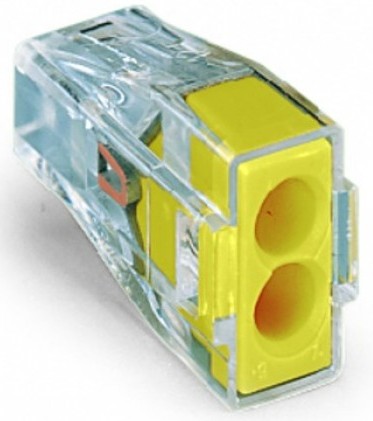
It will not work to remove the wire from the disposable without damaging the spring.
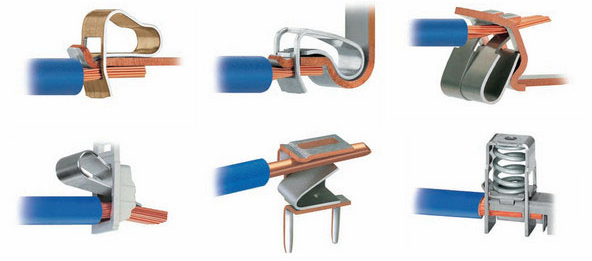
As you can see in the photo, the spring stands at an acute angle in the direction of the wire, so when you try to remove it, you will not succeed. Moreover, wires with a multi-wire core cannot be clamped in them either, unless you first irradiate it or put on a tip, but you will find out about this after reading the article to the end.
A number of these problems have been resolved in reusable terminal blocks. They have a spring of a different design, various spring options are shown in the photograph.
In the photo 1,2,4 springs allow you to remove the wires without much effort. The cases of such terminals are different, they have a hole for introducing an awl or a thin screwdriver into it.
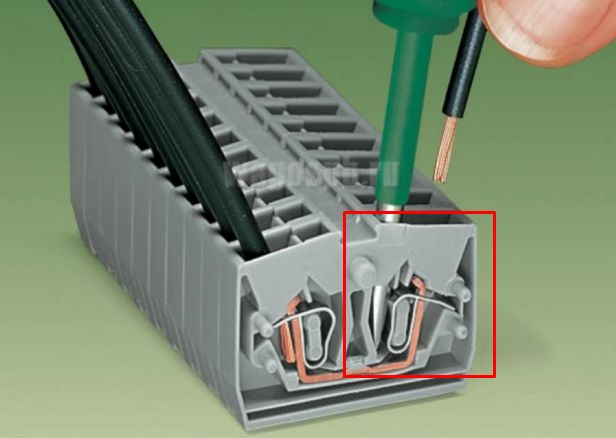
Or a bar on which you can press and release the spring tension, which will release the conductors. Depending on the model, such terminals can clamp wires with a cross section of up to 4 square meters. mm
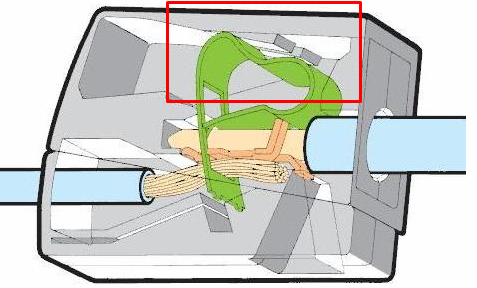
Lever or push terminals
Lever terminal blocks are a type of reusable spring terminal. The difference lies in the fact that to loosen the spring clip you do not need screwdrivers and an awl, just raise the lever, after which its pusher presses a certain place in the spring, an example of how such a terminal is shown in the figure below.
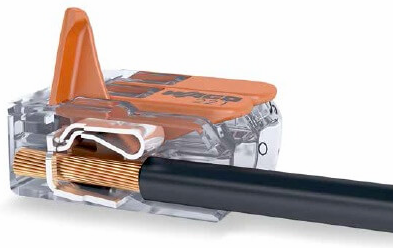
The most popular manufacturer of lever and spring terminal blocks is Wago, we wrote about them on the site earlier:
Modern terminals for connecting wires
How are the WAGO terminal blocks arranged?
How to distinguish a good self-clamping terminal block from a fake
Varieties of screw terminals
Screw terminals also come in many designs.Let's consider some of them. The first in the review will be a carbolite-based screw terminal block. Instead of carbolite, another dielectric material, such as plastic or PVC, can be used.
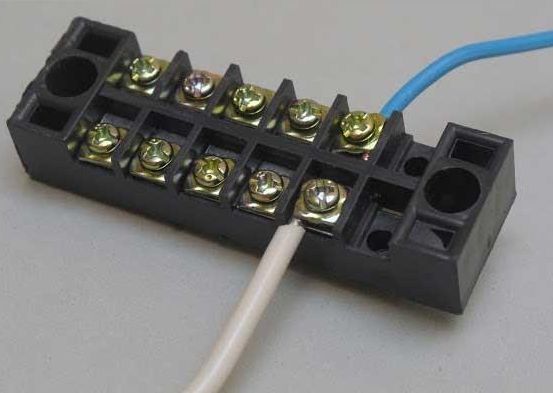
It can be additionally covered with a transparent cover, for additional protection against touching and ingress of foreign objects.
The screw presses the plate, often p-shaped, which fixes the wire, the screws are connected in pairs - opposite each other with a conductive bus. It is better to connect wires rolled into rings or with corresponding terminals at their ends to such terminals.
Please note that all screws are separated from neighboring partitions, this increases reliability and reduces the likelihood of shorting adjacent connections.
Another wire connection option is screw clamps they are used everywhere, it is also convenient to use in junction boxes. Usually they go in a block from which you can cut off as many clamps as you need.
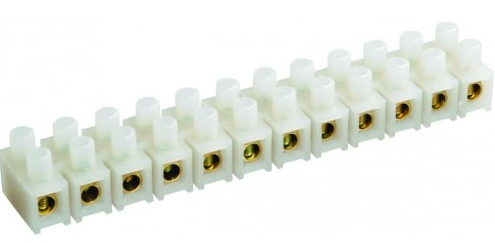
There are different diameters, respectively, they can clamp wires with a cross section of 1.5 to 35 square meters. mm
PCB Terminals
To connect the wires to the printed circuit board, screw terminal blocks are used, they differ in the way the wires are clamped.
1.Petal
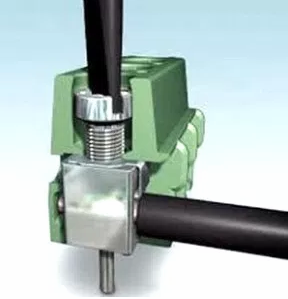
2. Lift
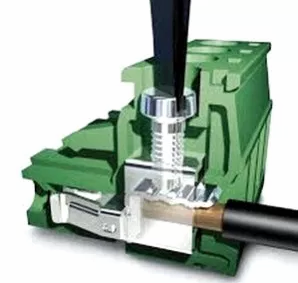
3. TOP-clamp

The wires are connected to them from thin (0.08 sq. Mm) to thick with a cross section of 25 sq. mm
By design, they can be both single (for one wire) and for a larger number of wires.
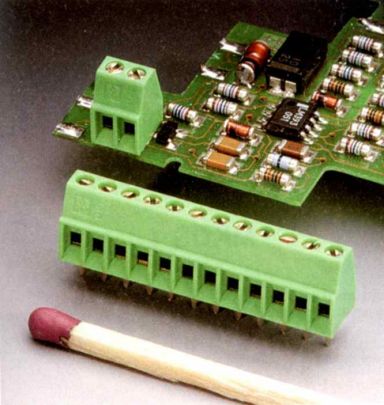
DIN Rail Terminals
According to the location method, the terminal blocks can be screwed to the housings of electrical appliances, not screwed to anything, holding onto wires or din rail mount. This is a reliable and unified mount that is used in many electrical panels.
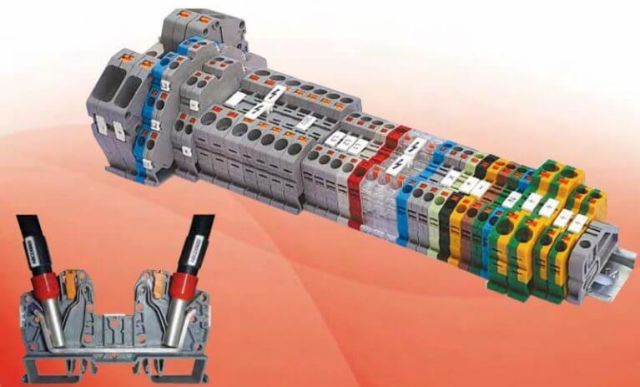
Manufacturers produce a wide range of varieties for various cross-sections and applications. There are the same types as usual: screw, spring, lever type.

By design, they can be either single-level, or two or more, as in the photo below.
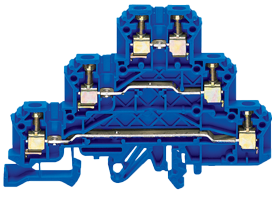
Additional items
Jumpers for connecting terminal blocks and devices on a Din rail. They are convenient for connecting a group of electrical appliances to one bus, saving space, because doing it with wires is not only convenient and not so obvious.
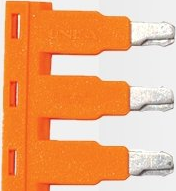

It was said above that flexible wires with multi-wire cores are not suitable for connection to terminal blocks in some cases. This is due to the fact that in disposable spring terminals, due to the design of the latter, you will not be able to insert a soft core into the spring. And in the screw clamps the stranded conductor will gradually flatten, even if you tighten the screw all the way, there is a chance that over time the contact will deteriorate or the thin veins are damaged when tightened.
The same problem arises when connecting a soft wire to the terminals of automatic machines and magnetic starters, as well as many switches.
There are two options left - to tin the core or compress it with a cable lug of this type.
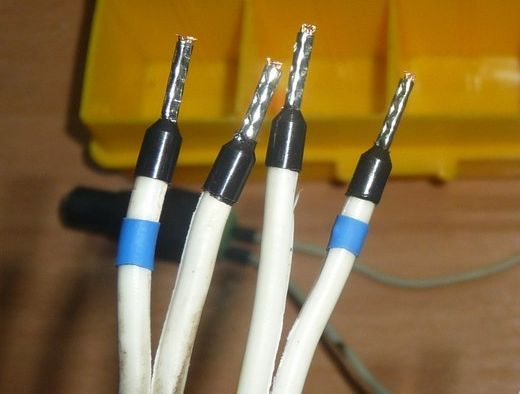
The range of such products is quite wide, there are round terminals for crimping wires, they are convenient to use when connecting soft wires to screw terminal blocks on a carbolite base or for direct connection using bolts.
Conclusion: what to look for when choosing
When choosing a method of connecting the wires, the conditions in which the electrical installation will work, as well as the currents that flow through this circuit, are guided. If the installation involves periodic maintenance or reconnection, it is better to give preference to screw terminals, and if you do installation 1 time and for a long time - disposable connectors - spring terminal blocks and sleeves - would be better.
We examined the main features, it is worth noting that the terminal blocks differ not only in the way the cable is fixed, but also in the connection angle, for example 180, 120, 90 degrees - in some situations they are irreplaceable.
The connector housings must be made of non-combustible material, since any electrical contact generates heat, and your safety depends on it.
Do not save money when buying cheap terminals; pay attention to the products of well-known brands, such as: Wago (most often used to work in distribution boxes), Phoenix Contact (old German manufacturer), Weidmüller (mainly their terminals are designed for din-rail operation) , IEK (low-cost and widespread electrical equipment, manufactures from terminals to switching devices).
When buying, specify whether this product is intended to work with a specific core material - aluminum or copper, and whether it is possible to connect conductors from different metals in it. For aluminum wires, terminal blocks filled with quartz-vaseline ointment are sold.
See also at bgv.electricianexp.com
:
